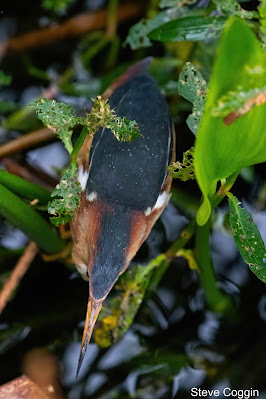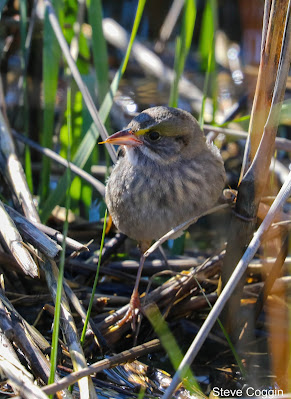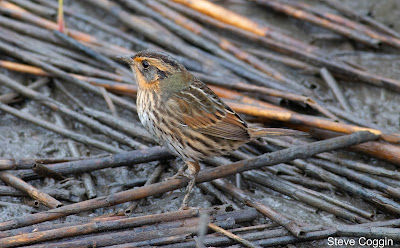 |
| A male Ruby-crowned Kinglet (Corthylio calendula) displaying its red crown. Rowan County, North Carolina. |
The crown has been a symbol of royalty for thousands of years. This distinctive piece of headgear denotes power and authority. Not incidentally a crown makes the wearer appear taller, contributing to the aura of superiority. But the crown is also an anatomical term indicating the top of an animal's head. Quite a few birds have impressive crowns and some even bear a crown in their name. We will explore some of these crowned birds in this and the next blog.
 |
| A female Ruby-crowned Kinglet without a red crown. Mecklenburg County, North Carolina. |
We have two species of kinglets in
the southern United States, the Ruby-crowned Kinglet and the Golden-crowned Kinglet. These tiny birds breed in coniferous
woodlands from Alaska to Maine and down the Rocky Mountains. In winter they move south and are regular
visitors to our area. Kinglets combine
both royalty and a crown in their names.
The name kinglet comes from their fearless defense of nests and their mobbing
of predators much larger than themselves.
Ruby-crowned Kinglets (Corthylio calendula) are olive-gray with white
wing bars and a white eye ring. The
males have red feathers on top of their heads, the ruby crown, but this is only
visible when the bird is upset.
 |
| A Golden-crowned Kinglet (Regulus satrapa) with yellow crown. Rowan County, North Carolina. |
The name of Golden-crowned
Kinglets (Regulus satrapa) has even more royal references. The genus, Regulus comes from the Latin root rex, meaning king. The
species name, satrapa, is derived from ancient Persian and denotes a
governor of a province. Golden-crowned
Kinglets are similar in size, shape and color to Ruby-crowned Kinglets. The key differences are Golden-crowned
Kinglets have an eye line rather than an eye ring and a golden stripe on the
top of the head.
 |
| A Double-crested Cormorant (Nannopterum auritum) with traces of the crests. Green Cay Wetlands, Palm Beach County, Florida. |
Lots birds have crests on their crowns. Double-crested Cormorants (Nannopterum auritum) are large dark birds found around fresh and salt water where they catch fish. In the breeding season they sport two plumes on their heads, the double crests. Both male and female Double-crested Cormorants have crests and these undoubtedly make them attractive to the opposite sex. These crests are often hard to see but one morning in Florida we ran across a Double-crested Cormorant with small crests on its head.
 |
| A Blue Jay (Cyanocitta cristata) showing its crest. Huntington Beach State Park, South Carolina. |
Blue Jays (Cyanocitta cristata) are common birds throughout eastern North America. They are known for their bright colors, raucous calls and a prominent crests. The crest is so emblematic, the specific name for the Blue Jay, cristata, means crested. A Blue Jay’s crown feathers are longer than other head feathers and the bird can raise and lower the crest. When a Blue Jay is calm the crest lays down on the head. But when agitated, as when it sees a predator, the Blue Jay raises its crest making the bird appear larger and more formidable.
 |
| A Yellow-crowned Nightheron (Nyctanassa violacea) with its yellow crown and plume. Rowan County, North Carolina. |
Yellow-crowned and Black-crowned Nightherons are named for colors of their crowns. Both these short-necked herons rest during the day but become active at night. Nightherons have large red eyes, the better to see with while hunting in the dark. The Yellow-crowned Nightheron (Nyctanassa violacea) has a gray body and wings, a black head with a white cheek patch and a pale-yellow crown. During the breeding season both males and females have long yellow plumes trailing from the top of the head.
 |
| A Black-crowned Nightheron (Nycticorax nyctiocorax) resting during the day. Huntington Beach State Park, South Carolina. |
The Black-crowned Nightheron (Nycticorax
nycticorax) has a gray body, black wings and a black crown. Nightherons are ambush predators, patiently
sitting at the waters edge and striking out to capture fish and other small aquatic
creatures.
 |
| A Tricolored Heron (Egretta tricolor) with a bright white plume on its crown. Green Cay Wetlands, Palm Beach County, Florida. |
Several other species of herons and egrets, including the Tricolored Heron (Egretta tricolor), have a plume on the crown during the breeding season. This elegant decoration complements the bird's gray body, white belly and sharp beak.
The most spectacular crown I know is owned by the Royal Flycatchers in the genus Onychorhynchus. Four species of Royal Flycatchers range from southern Mexico to Peru and Brazil. My friend Strummer Edwards was in Peru last summer doing bird research and captured an Amazon Royal Flycatcher (Onychorhynchus coronatus) that showed off its royal crown.
Crests and crowns are widespread
in the avian world. They are used to attract
mates, defend territories and intimidate predators. We continue looking at these crowned birds in the next blog.









































